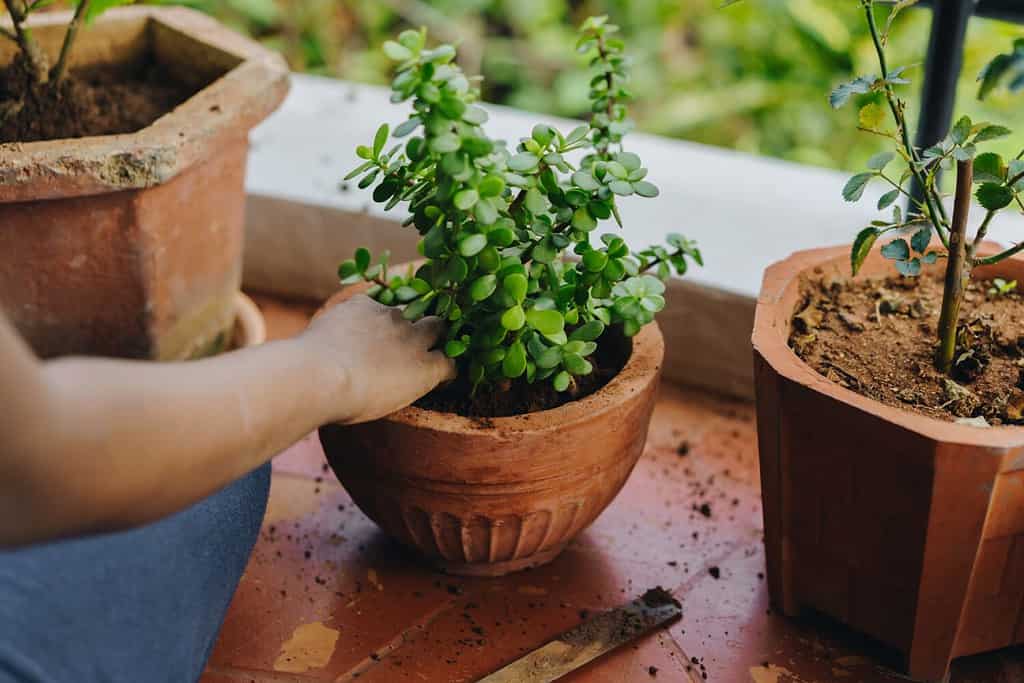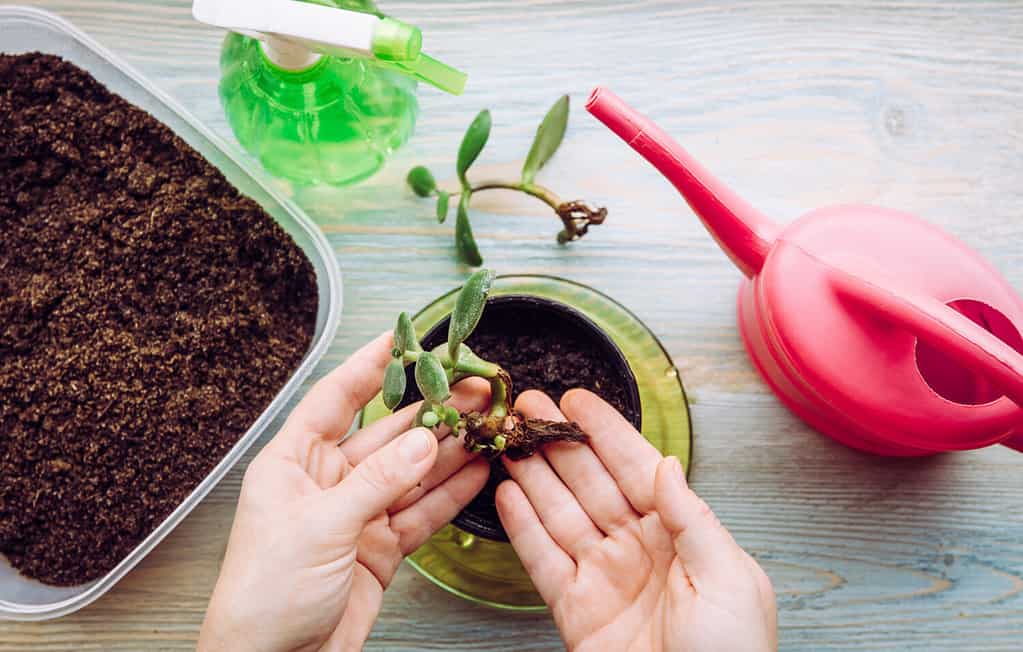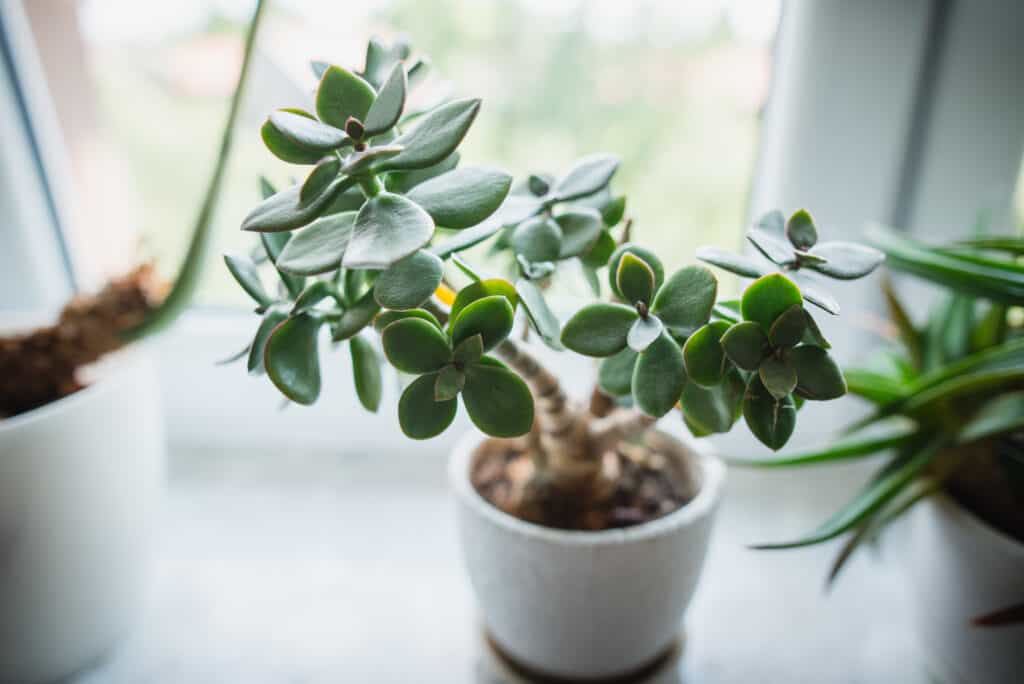Jade plants are one of the longest-standing ornamental house plants. These stunning succulents have an extensive lifespan and a rich cultural history.
In this article, we’ll dive into jade plant care and growth tips and how to place this coveted plant in your home to practice Feng Shui.
Let’s dig in!
Jade Plant: Origins

is best known for its prevalence in Feng Shui.
©Sahana M S/Shutterstock.com
Jade plants, scientifically known as Crassula ovata (thick and egg-shaped), are best known for their symbolism and cultural significance in Asia. According to Feng Shui, placing a jade plant in your home will attract luck, wealth, prosperity, or all three!
While this plant has become synonymous with Asian culture, it’s actually native to the Southern parts of Africa. This shrub-like succulent was known as umxhalagube in the local dialect. Due to its tree-like appearance, many people are unaware that the jade plant is a succulent.
Jade Plant: Appearance
Jade plants have woody stems with plump, ovaline green leaves. The stems grow upright and branch outward, contributing to its tree-like appearance. New stem growth starts out green and fresh, then hardens to a woody brown with time.
The leaves may develop a red edge, similar to a plush plant, when exposed to prolonged sunlight.
With proper care, jade plants produce white-pink stellate flowers. While most grow this plant indoors, it will grow over five feet tall outdoors in ideal conditions.
How to Care for a Jade Plant
Like most succulents, jade plants are resilient and easy to care for. Its greatest weakness is the cold, so be sure to keep this plant indoors during the frosty season and place it away from drafts. It will grow outdoors in USDA zones 10-11.
1. Soil Selection
Jade prefers well-draining succulent soil that resembles the sandy slopes of its home in South Africa. It will even tolerate cactus soil.
Do not plant your jade in regular potting soil, as it won’t provide sufficient drainage.
2. Watering
Jade prefers to be dry and somewhat neglected. This may seem counterintuitive due to its vibrant leaves and tree-like appearance. However, as a succulent by nature, it’s best to let the soil dry completely between waterings.
During the summer, plan to water your jade plant every two weeks. Test the soil regularly. If it dries before that period, water it more frequently. Reduce the frequency during the fall and winter as the plant enters its dormancy period.
3. Sun Exposure
Jade plants can live in low light, but they will not thrive. This succulent loves bright, indirect sunlight for 6-8 hours per day. Without enough light, your jade will etiolate. If you’re following Feng Shui and place your jade in a poorly lit area, supplement with a grow light.
Avoid placing this plant in direct overhead sunlight, as it may get scorched.
4. Maintenance and Care
Prune your jade plant to promote fuller growth. Use clean, sharp shears to trim away dead leaves and leggy stems. You can also pinch off new shoots for a bushier plant.
Jade battles the same pests as other succulents. Mealybugs are the most common offenders, closely followed by scale insects and spider mites. Wipe down your jade with a warm, wet cloth and dish soap. Treat the plant with neem oil if the issue continues.
5. Repotting and Fertilization
Jade requires repotting every few years as the roots start to get crowded. If the roots are starting to peek out the bottom of the pot, you’re overdue.
Choose a pot that’s slightly larger than the root ball without providing too much room, allowing approximately 2-3 inches.
Feed your jade with succulent-friendly fertilizer during the spring. Avoid fertilizing during the fall or winter when the plant is going dormant.
How to Propagate a Jade Plant

Propagate jade with stem or leaf cuttings.
©FotoHelin/Shutterstock.com
Jade is easy to propagate via stem or leaf cuttings. Many plant parents do both at the same time, as you must remove a few leaves near the bottom of the stem cutting to plant it.
- Use clean sheers to cut an established jade stem near the base.
- Gently remove leaves near the bottom of the stem and set aside.
- Let your stem and leaf cuttings callous over in a dry space with indirect sunlight.
- After a few days, dip the cuttings in rooting hormone and plant in a dish of succulent soil. Push the stem into the soil so it stands up. Place the leaves on top of the soil and gently cover the calloused ends.
- Mist the cuttings regularly until roots are established (3-4 weeks).
- Once established, separate and transplant the cuttings to new pots.
You can also propagate a stem cutting in a cup of water. Ensure the remaining leaves are above the water and change it regularly to prevent bacteria growth. Once the roots grow, transfer it to succulent soil.
Where Should a Jade Plant Be Placed in the Home?

Place jade in the Southeast part of your home or near an entryway.
©Jus_Ol/Shutterstock.com
There are a few places to place jade in your home, according to Feng Shui. Placing it by the front door welcomes wealth and prosperity into your home.
According to the Feng Shui Bagua map, the South East represents wealth and prosperity, and the wood element. Placing your jade in this part of your home is proper Feng Shui.
One caveat to consider: Feng Shui aside, you should place your jade where it needs to be to grow and thrive. Avoid cold drafts from your front door, and ensure this plant has ample sunlight.
Are Jade Plants Toxic?
According to the ASPCA, the jade plant is toxic to pets. It may also cause distress to children if ingested. Place this plant out of reach.
Thank you for reading! Have some feedback for us? Contact the AZ Animals editorial team.








